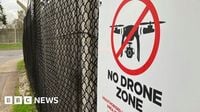British military bases are set to become much less hospitable to hostile drones, as the government announced sweeping new powers allowing troops to shoot down unmanned aerial vehicles on sight. The move, unveiled by Defence Secretary John Healey on October 20, 2025, comes amid mounting fears of Russian drone incursions and a broader surge in state-sponsored drone activity across Europe.
Until now, British soldiers and Ministry of Defence (MoD) Police have been able to use specialist counter-drone equipment—think signal hijackers and GPS jammers—to track, divert, or neutralize suspicious drones. Actually firing on an unidentified drone was only permitted in the most extreme circumstances, often after layers of bureaucratic clearance. But as The Telegraph and BBC report, that red tape is about to be slashed. The new rules, to be enshrined in the forthcoming Armed Forces Bill, will authorize a so-called "kinetic option," empowering troops to shoot down drones threatening military installations without waiting for higher approval.
“We will always do what’s needed to keep the British people safe, and as we speak, we are developing new powers – to be put into law through our Armed Forces Bill – to shoot down unidentified drones over UK military sites,” Healey is expected to say during a speech at the Lord Mayor of London’s Defence and Security Lecture, according to The Telegraph. The powers will initially apply exclusively to military sites, but government sources told The Telegraph that extending them to other critical infrastructure, such as airports, is not off the table.
This shake-up comes not a moment too soon. In November 2024, four British airbases used by US forces—RAF Lakenheath, RAF Mildenhall, RAF Feltwell, and RAF Fairford—reported mysterious drone sightings. The incidents prompted the deployment of 60 British troops to bolster security and assist the US Air Force in investigating the incursions. While neither British nor American officials have publicly identified the culprits, the context is hard to ignore. As BBC notes, these airbases have strategic value for US operations, with Lakenheath, for example, hosting F-22A fighter jets recently deployed after the US bombing of Iranian nuclear sites in June.
The drone threat is hardly confined to the UK. Across Europe, the skies have grown crowded—and dangerous. Monitoring service Enigma has tracked at least 18 suspect drones over Denmark, Sweden, Norway, and Germany since mid-September, many near airports. In Munich, Germany, airports were forced to close on consecutive days after unidentified drones appeared in restricted airspace. Denmark and Norway have seen similar disruptions, with airports shutting down amid aerial intrusions. While Russia has denied involvement, the timing and pattern of these incidents have set alarm bells ringing in capitals across the continent.
European leaders have not stood idle. A summit in Denmark earlier this month saw several EU member states back plans for a multi-layered "drone wall"—a system designed to detect, track, and, if necessary, destroy hostile drones, particularly those believed to be Russian. The urgency is clear: in September, twenty Russian drones crossed into Polish airspace, and Russian MiG-31 jets violated Estonian airspace later that month. According to The Telegraph, these acts are part of a broader Russian campaign to spread instability, including attempts to subvert Moldova’s elections.
Defence Secretary Healey plans to highlight the scale of the threat. According to Britain’s latest defence intelligence assessment, Russia launched around 5,500 one-way attack drones into Ukraine in September 2025 alone—over a thousand more than in August. More than 3,000 drones have already been launched in October. These so-called "kamikaze" drones have devastated Ukrainian energy infrastructure, killed at least 214 civilians, and injured nearly 1,000 in September, according to United Nations data cited by The Telegraph. Ukrainian military intelligence estimates Russia can produce about 2,700 Shahed-type drones each month, in addition to more than a million smaller, remote-controlled models annually. The BBC and The Economic Times both underscore how drones have become central to modern warfare, accounting for as much as 80% of battlefield casualties in Ukraine.
Britain is not simply reacting defensively. The new legal powers are part of a broader push to modernize homeland security and military capability. As LBC and The Telegraph report, the Strategic Defence Review published in June 2025 placed homeland defence at the heart of the MoD’s mission, pledging up to £1 billion for air and missile defence and doubling investment in autonomous systems to £4 billion this Parliament. The UK has also extended its contribution to NATO’s Eastern Sentry mission, with RAF Typhoon jets flying air-defence patrols over Poland until the end of the year.
On the technology front, the Royal Navy has just unveiled the Martlet missile—a lightweight, 13-kilogram projectile capable of traveling at one-and-a-half times the speed of sound. Already operational on Wildcat helicopters, the Martlet has completed frontline trials off the Welsh coast and in the French Mediterranean, successfully intercepting multiple drone targets, including the fixed-wing Albas. According to Defence Minister Luke Pollard, the missile represents “a significant leap forward for Britain’s military might,” showcasing precision and adaptability against both aerial and surface threats. The Martlet is already in service with the Army and Royal Marines, has been supplied to Ukraine, and is set to be exported to India under a £350 million defence deal.
Britain’s response to the drone threat is not limited to its own borders. As The Telegraph details, counter-drone specialists from the RAF Regiment were dispatched to Denmark this month following reports of suspicious aerial activity. More British experts are scheduled to deploy to Moldova later this month to help local forces develop counter-drone tactics, as part of a broader strategy to shore up Europe’s eastern flank against Russian aggression.
It’s not just drones, either. Defence chiefs are increasingly concerned about the risk of cyber attacks from adversaries like China and Russia, leading to the creation of a new Cyber and Electromagnetic Command as part of the June 2025 defence review. The government’s hope is that a combination of new legal powers, cutting-edge weapons, and international cooperation will allow the UK to respond rapidly and decisively to evolving threats—whether they come from the sky, the internet, or elsewhere.
As the Armed Forces Bill moves forward and the Martlet missile takes its place in the UK’s arsenal, one thing is clear: Britain is determined not to be caught off guard by the next wave of drone warfare.

